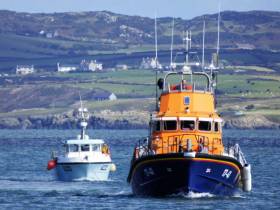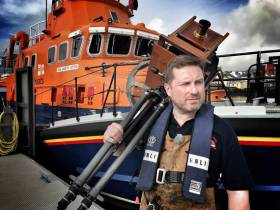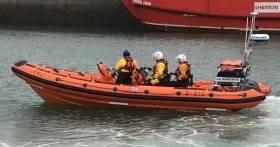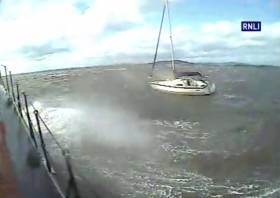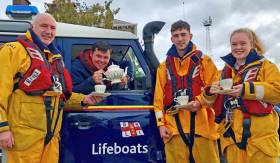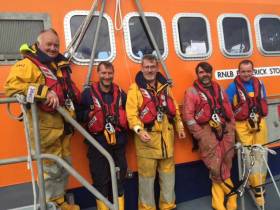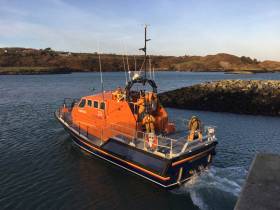Displaying items by tag: RNLI
Lough Ree RNLI Assists Two Fishermen in Difficulty
Lough Ree RNLI came to the aid of two fishermen who had lost engine power while enjoying the last day of the fishing season.
At 2.05pm yesterday Lough Ree RNLI Volunteers were alerted to two fishermen whose 17 foot fishing boat had broken down at Nun’s Island in the middle of Lough Ree. Conditions at the time were a blustery force 4-5 with choppy waters.
Upon arrival at Nun’s Island, the crew of Inshore Lifeboat The Eric Rowse, located the two fisherman safely ashore with their boat. When the fishermen saw the lifeboat arriving, they rowed out to meet them. After some assistance to clear weed from the propeller from the lifeboat crew, the fishermen were able to start their engine and made their way, under escort from The Eric Rowse and her crew, to Judy’s Harbour in Rinadoon Bay on the Roscommon shore of the lake. Once the two fishermen were safely in Judy’s Harbour, the lifeboat volunteers returned to the Lifeboat Station in Coosan Point.
Speaking on their return to base, Lifeboat Helm, Kieron Sloyan said, ‘as the evenings start getting shorter we would like to remind all using the lake to make sure they let someone know where they are going, when they plan to return and to always carry a means of communication either mobile phone or VHF radio with them.
Irish Fishing Vessel Rescued By Holyhead Lifeboat
#Lifeboats - Holyhead’s all-weather lifeboat launched yesterday morning (Saturday 29 September) to the rescue of an Irish fishing boat adrift in the Irish Sea with mechanical failure.
Pagers sounded for the Holyhead RNLI crew just after 8am following a distress call to HM Coastguard from the 10m potting vessel, which was some 21 miles northwest of Holyhead.
On reaching the stricken boat, the crew on the lifeboat Christopher Pearce set up a tow for the slow return to Holyhead. In all the lifeboat was five hours at sea.
Aafter ensuring all were well, the fishermen set off to return to Ireland on the next ferry, leaving their vessel to be repaired locally.
Holyhead coxswain Tony Price said: “The casualty craft and her crew were well-equipped. It’s always a shame for any craft or persons in difficulty, but it’s particularly sad when a vessel is earning her living from the sea, and we wish our Irish fishermen friends a speedy return to normality after their misfortune.
“I’d also like to send thanks to the local coastguard teams for helping with mooring the craft safely back in Holyhead.”
Photographer Reaches Halfway Mark On Epic Project To Capture Lifeboat Stations With Victorian Camera
#Lifeboats - After almost four years, Jack Lowe will this week reach the halfway point of his epic ambition to photograph all 238 stations in the RNLI network when he visits Dover Lifeboat Station.
Since he began The Lifeboat Station Project in January 2015, Lowe has photographed more than 2,000 lifeboat volunteers — and around a dozen dogs, who are often included if their owners are on the crew — using wet plate collodion, a Victorian process that creates stunning images on glass.
And he produces his work on the road in ‘Neena’, a decommissioned NHS ambulance he’s converted into a mobile darkroom.
By the time he reaches Dover this week, he will have been to 140 lifeboat stations and created images on over 1,500 glass plates.
Making his images has taken 120 litres of developer and 45 litres of collodion.
He’s also driven over 28,000 miles, which is more than once round the world, and used about 8,400 litres of fuel – and stayed at more than 100 B&Bs.
This major landmark comes as the RNLI has announced that Lowe’s work will feature in a major exhibition, Calm Before the Storm: The Art of Photographing Lifeboats, in 2019.
But it hasn’t all been plain sailing.
This time last year, Lowe’s tour took him to Ireland, where he photographed the volunteers crews at stations along the South Coast from Waterford to Kerry.
After Lowe had completed his 100th station — Valentia in Co Kerry — he revealed to his social media followers that he was struggling to keep going.
His struggles were physical, emotional — and financial, as the project is largely self-funded.
But thanks to the support of fans of his work via the crowdfunding platform Patreon, Lowe was able to continue the project on a surer footing.
“Ultimately, I’m honoured beyond words to be making this archive,” Lowe said. “It’s a privilege spending time with so many lifeboat volunteers, preserving their bravery and devotion for future generations.
“This journey is unprecedented in so many ways. The further I travel, the deeper the body of work becomes on just about every level and in ways that I could never have foreseen or imagined.”
The Lifeboat Station Project’s dedicated website has links to Lowe’s Facebook, Twitter and Instagram feeds, as well as his Patreon campaign.
Baltimore RNLI Welcomes Inshore Lifeboat On Service
#Lifeboats - Baltimore RNLI has welcomed its new Atlantic 85 class inshore lifeboat on service in the West Cork village.
The inshore lifeboat arrived at Baltimore lifeboat station on Thursday 13 September and replaces the Atlantic 75 class lifeboat, Patricia Jennings, which has been used to save lives at sea in Baltimore since 2016.
Last week saw the volunteer lifeboat crew undertake familiarisation training on the Rita Daphne Smyth, and the new inshore lifeboat officially went on service at Baltimore lifeboat station last Thursday evening (20 September) alongside the all-weather lifeboat Alan Massey.
The new lifeboat has been funded through a legacy from the late Rita Daphne Smyth, a native of Harrow in Middlesex, England, who was a supporter of the charity’s volunteers in saving lives at sea.
The Rita Daphne Smyth will be officially named at a special
ceremony and service of dedication.
In her two years in Baltimore, Patricia Jennings launched 21 times, with its volunteer lifeboat crew rescuing 17 people.
The new lifeboat has some advancement on its predecessor. The Atlantic 85 is 10m longer than the Atlantic 75 and allows room for four crew members onboard rather than three.
The lifeboat is powered by two 115hp engines and has a stronger hull and greater top speed of 35 knots. The added radar allows the crew to operate more effectively in poor visibility and there is also VHF direction-finding equipment.
The vessel has a manually operated self-righting mechanism which, combined with inversion-proofed engines, keeps the lifeboat operational even after capsize. The lifeboat can also be beached in an emergency without causing damage to its engines or steering gear.
The Atlantic 85, which was introduced to the RNLI fleet in 2005, also carries a full suite of communication and electronic navigation aids, as well as a searchlight, night-vision equipment and flares for night-time operations.
Baltimore RNLI lifeboat operations manager Tom Bushe said: “We are extremely grateful to Miss Smyth for the generous legacy donation which has funded our new lifeboat.
“As we welcome a new lifeboat, there is also a sense of nostalgia among us today too as we bid a fond farewell to Patricia Jennings who provided us with two great years of service.
“Patricia Jennings time here in Baltimore brought many people safely to shore and we hope her donor family will be just as proud as we are, of her many achievements.
“We are looking forward to being the custodians of this new lifeboat which will allow our volunteers to go on to rescue and save many more lives in the years to come.”
Weekend Callouts For Arklow & Skerries Lifeboats To Fishing Vessels In Difficulty
#Lifeboats - Arklow RNLI’s all-weather lifeboat crew left their Sunday lunch on 23 September to attend to a fishing vessel in difficulty east of Cahore Point in Co Wexford.
Once the vessel and its crew of three were located, it was established that while it had power, it could not make any headway due to its propeller being fouled with fishing gear.
The lifeboat volunteers rigged a tow line and set up for a long slow tow home to Arklow. All hands came ashore safely some five hours later.
Mark Corcoran, community safety officer at Arklow RNLI, said: “We would like to remind people to respect the water and always wear a lifejacket and carry a means of calling for help when going out on the water.”
The previous evening, Skerries RNLI was tasked to another fishing vessel which suffered mechanical failure and lost engine power less than half a mile north of Skerries harbour.
The struggling 22m fishing boat, with a crew of seven on board, was well lit and visible from the shore so the Atlantic 85 lifeboat Louis Simson made its way quickly alongside.
With the fishing vessel drifting dangerously close to the shore, it was decided to establish a tow to bring safely alongside the harbour.
Speaking about the callout, volunteer lifeboat press officer Gerry Canning said: “This was quite a large vessel for us to take under tow, but the conditions were very fair on the night and the Atlantic 85 was very much up to the job.”
Three Yachts Rescued In Strangford Lough During Storm Ali
#Rescue - Newcastle RNLI was involved in the rescue of three yachts in Strangford Lough during Storm Ali on Wednesday (19 September).
The lifeboat volunteers were first alerted at 11.40am to go the aid of a stricken yacht at Newtownards Sailing Club in Co Down.
As the all-weather lifeboat launched, under coxswain William Chambers, it quickly became apparent the challenging weather conditions the crew would face on their passage to Newtownards.
The main water tight doors were closed and all crew seated as they faced eight-metre waves hitting from the side.
A Force 8 gale was blowing as the crew approached Strangford Lough. It was some 90 minutes later before the seas started to settle as the lifeboat was sheltered by the shore.
On arrival at Newtownards at 2.15pm, the coastguard was concerned that there may be a person onboard the weather-beaten yacht, Newcastle RNLI confirmed that nobody had been on the boat and she was safely on the mooring.
The lifeboat was then requested to go the aid of another yacht drifting across the lough from White Rock and Kircubbin, but unfortunately by the time the volunteers reached the vessel there was nothing they could do as it was on the rocks on an ebbing tide.
On return to station, approaching Portaferry, the crew were alerted to a third yacht in difficulty. The crew established a tow line and managed to free the vessel and towed it to the safety off a mooring in Strangford.
Leaving the sheltered waters of Strangford Lough, the lifeboat and its crew once again faced mountainous seas and the coxswain decided to stop in Ardglass Marina for an hour to let the wind decrease and the wave size drop.
Leaving Ardglass around 6pm, the crew faced large but bearable seas, making it back to Newcastle an hour later.
“This was a challenging day for our volunteers given that we launched into rough seas when Storm Ali was at its worst,” said Chambers of the seven-hour shout.
“It was also uncertain at that point if there was a life at risk onboard the yacht. Thankfully there wasn’t in this case.
“It was a long and challenging day but our volunteers are highly skilled and trained for these situations and were delighted to be able to help.”
Larne Lifeboat Crew To Open Their Doors For Macmillan Charity Coffee Morning
#RNLI - Larne’s volunteer RNLI crew are throwing open the doors of the lifeboat station as they host a coffee morning to raise funds for Macmillan, the cancer support charity, from 10.30am to 2pm on Saturday 29 September.
The crew are already planning a ‘bake off’ to entice the public along and to dig deep for Macmillan.
There will also be tours of the station, demonstrations of its vital lifesaving kit and talks to give an insight into lifeboat launches in and around Larne.
Eleganze Hair & Beauty, Marty’s Catering, Curran Court Hotel and Allan Dorman & Son are among the local businesses that have already shown their support with raffle prizes for the day.
“This will be a fundraiser with a difference for us here,” said lifeboat mechanic Derek Rea. “As a charity we are thankful to the people of Larne for supporting the lifeboat but we also want to help others and raise funds for this worthy cause.
“There is hardly a person whose life has not been touched by cancer, either through battling it themselves or seeing someone they care about suffering with it. Support for cancer sufferers and research into treatment is ongoing and the Macmillan coffee morning is a great way to raise awareness and funds for this work.”
The lifeboat station is situated at 11 Olderfleet Road in Larne and people wishing to learn more about the Macmillan coffee morning fundraisers can visit macmillan.org.uk.
Two Callouts In 24 Hours Keep Portaferry Lifeboat Volunteers Busy
#RNLI - Yesterday evening (Saturday 15 September) at 4.45pm, a volunteer RNLI crew from Portaferry launched to the aid of two men in trouble in the water just off Ballyhenry Island.
The two men had been using a personal watercraft when one of them had fallen from the vessel and was struggling to get back to it.
The second man, realising that the first was in difficulty, started to swim from the shore to try and help at the small island, around 1.5 miles north of Portaferry on the eastern shore of Strangford Lough in Co Down.
At the time, the weather was cloudy with good visibility, a southerly wind and calm seas.
Portaferry RNLI launched at 4.50pm and 10 minutes later were on scene, where the lifeboat crew took both men on board before returning them to Cooke Street Quay in Portaferry and into the care of the Portaferry Coastguard team.
The second launch was this morning (Sunday 16 September) in response to a Mayday call regarding an angler who had fallen from rocks into the sea just off Ardglass Golf Course.
Pagers sounded at 8.36am and the crew were on the water six minutes later, arriving on scene at 9.10am.
Weather conditions at the time were overcast with good visibility, a south-westerly Force 3 wind and moderate seas.
The male casualty had in the meantime been picked up by a local boat and returned to shore at Ardglass Marina. The lifeboat continued to the marina where they administered casualty care before leaving him in the care of the local coastguard team at 9.40am.
Commenting on the weekend’s events, Portaferry RNLI lifeboat operations manager Simon Rogers said: “We can go for weeks without any callouts, but during those quiet periods our volunteer boat and shore crew members train hard every week, preparing for situations such as this.
“It is thanks to their dedication and hard work that we are able to respond so quickly an as often as required to help those in trouble at sea.”
Courtmacsherry Lifeboat in Rescue of Two Anglers in Pleasure Boat off The Old Head of Kinsale
The Courtmacsherry All Weather RNLI Lifeboat was called out at 2pm yesterday to go to the aid of an 18–foot pleasure boat with two anglers on board who got lost and sought assistance two miles south of the Old Head of Kinsale in West Cork.
Under Coxswain Sean O Farrell and a crew of five, the Lifeboat was underway within minutes. The distress alarm was raised by the two Belgian Anglers who were fishing off the coast at the Old Head of Kinsale and got lost as they headed out to sea.
"the only bearing that they could give was that they could see a Lighthouse in the distance"
As the seas were rough and wind picking up, the only bearing that they could give when seeking assistance was that they could see a Lighthouse in the distance.
The Lifeboat found the anglers at 2.30 pm and duly escorted the fishing craft back to the village of Courtmacsherry, arriving at 4.10 pm.
Both anglers were relieved to be back on shore and they praised the fast response and skills of the Lifeboat Crew in locating them.
The crew on today's callout were Coxswain Sean O Farrell, Mechanic Stuart Russell and crew Ken Cashman, Austin McKenna and Conor Dullea.
Baltimore Lifeboat Called Out To Search For Missing Swimmer
#RNLI - Baltimore RNLI launched yesterday morning (Tuesday 11 September) to a swimmer reported missing on a swim from Skibbereen to Baltimore in West Cork.
The inshore lifeboat was called to search the Ilen River for the swimmer after a safety boat lost visual contact with him during a squall north of Inishbeg.
Within an hour they were joined by the all-weather lifeboat to search the narrower channels of the river. Toe Head Coast Guard and the Shannon-based Irish Coast Guard helicopter Rescue 115 also assisted.
Some 40 minutes later, at 11.10am, Mizen Head Coast Guard informed all rescue agencies that the swimmer had made his way safely to shore, and all were to stand down.
“This was a great example of multiple rescue agencies working together and thankfully ended with a good outcome,” said Baltimore RNLI press officer Kate Callanan.
Elsewhere in Cork, Ballycotton RNLI launched both their all-weather and inshore lifeboats on Friday afternoon (7 September) to a capsized small sailing dinghy off Ballynamona beach.
A concerned member of the public had witnessed the casualty having difficulty righting the capsized dinghy, which was some 400 metres from the beach.
The crew on board the inshore lifeboat located the casualty in the water approximately 80m from the scene attempting to swim ashore.
The male casualty, believed to have been in the water for nearly 30 minutes, was brought onboard the inshore lifeboat and transferred to the larger all-weather vessel where he was administered first aid, then brought ashore where a local doctor and ambulance crew were waiting to assist.
“Thanks to the vigilance and very quick thinking of the local members of the public, they contributed to a speedy recovery with a positive outcome for all involved,” said Ballycotton RNLI coxswain Eolan Walsh.




























